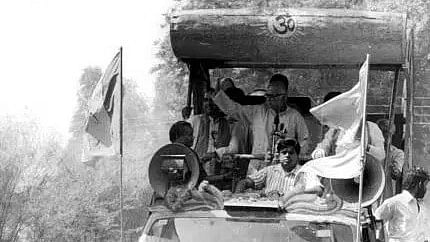
Ram Rath Yatra passing through a street in New Delhi on 14-10-1990.
Credit: DH Archive
As many Indians celebrate the consecration ceremony of Lord Ram's idol in Ayodhya, the ceremony can also be seen as a win for L K Advani's BJP in the face of Narendra Modi's BJP.
BJP's then-president, L K Advani led the Ram Rath Rath Yatra in the 1990s, laying the foundation for the Ram temple movement. However, what started as yatra of 'devotion', quickly changed to 'disorder' when it sparked communal tensions across the country.
Lets take a look at the places the chariot travelled and the chaos that followed in its wake.
The yatra schedule
The politico-religious yatra organised by the BJP and its affiliated Hindu organisations, began on September 25, 1990, and ended on October 30, same year.
The purpose of the yatra was to support a right-wing Hindu organisation, Vishva Hindu Parishad's (VHP) agitation to construct a temple for Lord Rama at the site of the Babri Masjid, which they believed to be the birth place of the mytho-religious figure Rama.
The yatra commenced in Somnath and was scheduled to conclude in Ayodhya but owing to the growing communal violence, Advani was arrested in Bihar when Lalu Prasad was the state's Chief minister.
The initial plan of the yatra was to travel through six states — Gujarat, Maharastra, Andhra Pradesh, Madhya Pradesh, Rajasthan, Bihar — before reaching Uttar Pradesh, where the groups planned to force the government to hand over the mosque site for temple construction.
On an average, the yatra covered 300 kms daily and Advani addressed six public meetings a day.
In one of his speeches, Advani claimed to inherit the mantle of Sardar Patel who had brought about a 'resurgence of the national spirit' by rebuilding the Somnath temple, thus linking Somnath (the commencing yatra location) to Ayodhya (the concluding yatra location).
It became the symbol of the Hindu resolve to reclaim the temple at Ayodhya as was done at Somnath and eventually triggered communal chaos.
Chaos followed the chariot
From its beginning, the yatra sparked communal tension between Hindus and Muslims. Widespread communal riots took place across the country between September 1 to November 20.
564 people across the country — 27 in Andhra Pradesh, 7 in Assam, 19 in Bihar,8 in Delhi, 99 in Gujarat, 88 in Karnataka, 3 in Kerala, 21 in Madhya Pradesh, 4 in Maharashtra, 52 in Rajasthan, 6 in Tamil Nadu, 224 in Uttar Pradesh and 6 in West Bengal — lost their lives in the riots.
It was during V P Singh's rule that the yatra took place and before proceeding to Bihar, Advani paused the yatra in the national capital challenging the government to arrest him but was not arrested until the yatra crossed the Uttar Pradesh border.
As Singh was in constant touch with the then Bihar Chief minister Lalu Prasad regarding the communal violence outbreak, on October 23, he authorised Prasad to arrest Advani as the yatra crossed the state's border with Uttar Pradesh.
Despite his arrest, the yatra itself continued to progress towards Ayodhya. The then Chief minister of Uttar Pradesh, Mulayam Singh Yadav, ordered the arrest of all activists bound for Ayodhya, and 150,000 individuals were jailed.
Over three decades later, Ram temple was officially inaugurated at the site where the Mughal-era Babri Masjid once stood, the culmination of L K Advani's idea behind the Ram Rath Yatra.